Memories
Posters from pictures
Contributed by: Kevin Phillips
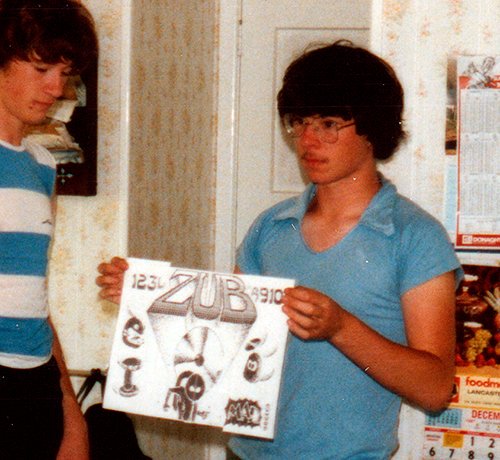
I recall wanting a poster of one of my favorite ZX Speccy games (ZUB). I’d just typed in (as you did back then) a printing tool that would allow pixels to be printed larger to create big prints. The Alphacom 32 printer I used was way superior to the ZX Printer – it produced a great result… Printed in around 3 strips, a bit of PVA glue onto a piece of paper and viole!
Wasn’t the best of course. Thermal paper doesn’t last the test of time. PVA glue was lumpy, and also made the paper soft and damp. And of course, its all in black-n-white. Colour printing wasn’t exactly easy back then… Hahaha…. ?
This piccy was 1986… I remember because I’m still wearing school uniform, whereas in the Form 7 year (the one after) there was no uniform requirement. It made dating this picture super-easy to work out. ?
One of the first web sites!
Contributed by: Craig Wilson
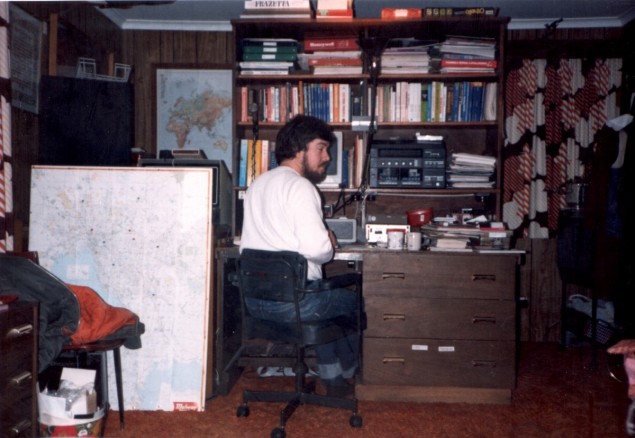
This is an image of one of the early privately run dial up web sites in Blackburn Melbourne.
It’s the only image left after all this time and that is me sitting at the console.
It ran on a dedicated phone line with an auto answer modem at the rocket speed of 300 bps (that is bits per second). The translation of that means with a perfect line, you got about 30 characters a second. The point of this is, that it was running on a Super 80 Mother-board with 8K of 8 bit memory. All loaded by tape on what should have been a game console.
Are you keeping up with the Commodore? (cos the Commodore is keeping up with you)
Contributed by: Tim Koch
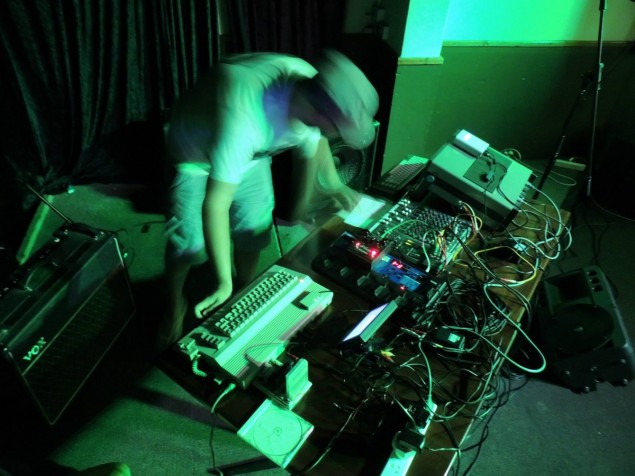
Perhaps not a memory, but a second coming – I grew up on Commodore64 games in the mid to late 1980s and was mesmerised by the sound capabilities at the time (consequently began recording music in the mid 90s with the Commodore Amiga series of computers). Jump forward thirty years and now I am playing full music gigs with purely Commodore64 equipment (there is still a healthy music scene based around the MOS SID chip that was the music powerhouse in all Commodore 64s). Next year the small label I run is releasing a hardware cartridge for the Commodore64 that features generative visuals and an album’s worth of original music .. still life in the beige box yet!
From the inside.
Contributed by: Craig Wilson
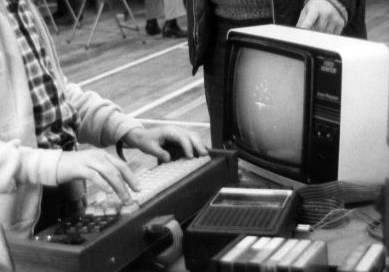
I was always interested in electronics and as the death of BW TV’s gave birth to a wave of discarded electronics, I explored them at a very young age (not to mention getting more than a few electric shocks). But when video games started to come out one of the first things I did was … well being the kid I was I took it apart! Looked at what the insides were like and then tried to figure out how it worked. Ok, to be fair, I played it until my parents stopped looking and then pulled it apart. But this resulted into a life long trade of electronics and repair or/and design. While on that journey I saw the progression from the most fundamental technology, all the way through to today.
There is a fundamental link between technology and gaming consoles that is not seen unless you crack the case and understand the things your looking at.
In the very early days, most small computers didn’t have clocks. This seems trivial at first glance, what would it matter if a game didn’t know the time. But what you need to understand is that the central part of the console was working as hard and fast as it could just to keep up with what was being asked of it. So it didn’t need a governor to slow it down when it wasn’t so busy.
But could you imagine the speed of to days computers running the efficiently coded games of the first consoles. The entire space invaders game would finish before it had a chance to be seen at all. What was needed was a sense of real world time to keep things slowed down for us slow humans.
This spare time was what made better graphics possible. Unlike the first game machines made entirely of parts that could be purchased of the shelf., more electronics started to be combined into pre-made dedicated chips, which also made them decentralized with part of the work shared eg sound, graphics, etc while the main controlling of the flow of the game remained in the CPU.
Eventually complete dedicated games reduced the price and the first truly simple games such as Pong were all on one chip. There were also follow up versions that you could select which game it played etc frogger/snake or pong. But so far the game development was limited in two ways.
1: Cost, if it could be done but was to expensive and it would only be an arcade console game. And that’s exactly what happened to start with.
2: Function, although the cost could be reduced to enter the domestic market, the functionality suffered.
Something else happened:
Some game consoles that were sold could actually play more than one game. But the manufacturer had designed them to play several. It’s not clear why this happened and I am only guessing here, but it seemed like the chips as they were being made were faulty to some degree. So rather than totally discard the silicon wafer. It was sold with only the game that worked. Internally setting the game to be played.
It’s at about this point when the line between computers and game consoles blend. At some stage in either the very late 70’s or early 80’s the games become small computers that no longer functioned be direct electronically hard wiring. i.e. a pinball paddle is directly linked to a switch in the button. But with a computer built in, the signal is sent to the pin on the chip and if the program is coded to fire the electronics that drive the paddle it moves.
With this, much less wiring was needed, power use was down, functionality was up and production costs and time dropped. Because of this, game/computer consoles were no longer different parts of the device and only the program determined the function of a device. The birth of the game cartridge!
Demo of Star fighter game @ Melbourne Super 80 User Meeting
Contributed by: Craig Wison
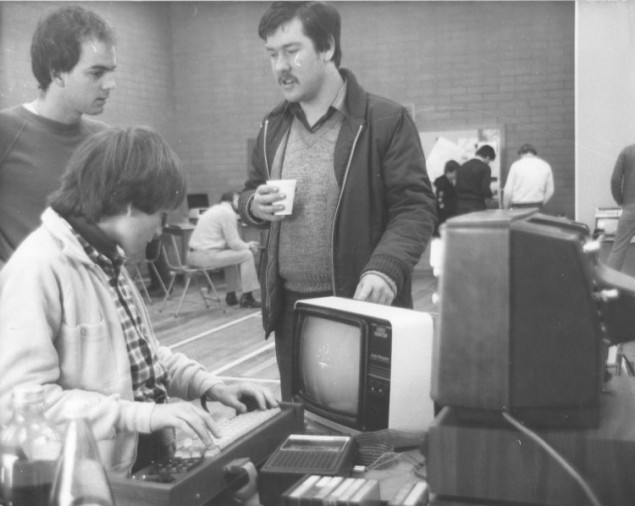
The Melbourne user group would meet each month to share and support other people interested in the Super 80 and later on some other Z80 like devices such as the TRS80 or Microbee.
Most of the people that came, had found out quickly that without the help from other people with an interest for home computers and what couldn’t be done with them. That these costly pieces if electronics were just no comparison to the completed devices in the market that had software for them. In some ways though it was also a strength that pushed people with to much time on there hands to do things that we wouldn’t believe possible with such devices today.
In the image you can see what seems like a simple game that you just played. In fact you had to spend months coding it, using audio tapes to store it on. Writing everything from the keyboard routine to the sound and random number generator for stars. It took a good 20+ min to start and load the game. If you assembled the computer the way Dick Smith Electronics intended (With Integrated Chip Sockets) then even a bump of the table could crash the whole thing and you have to start loading all over again.
To do what you see in the photo took a single user considerable effort. On the table you can just make out the Zilog machine code definition Hand book (next to the tape player). It listed every function the Zilog Z80 CPU had and what it did. The Super 80 Bible as it was and by the time you had been programming in machine code for a couple of years, you could read the numbers directly without referring to the book. The Matrix was far to complicated ….. ?
Australian Colecovision Championship – 1982
Contributed by: Helen Stuckey
Featured by Matt Keller on Retro Gamer Australia (in 2011) this video of the 1980s current affairs program Terry Willisee Tonight (TWT) shows 14 year old Victor Coleiro winning the Australian Colecovision Championship held in Sydney.
You can read Matt’s story here
http://www.retrogamingaus.com/769/the-1982-australian-colecovision-championship
Hanimex
Contributed by: Eddie
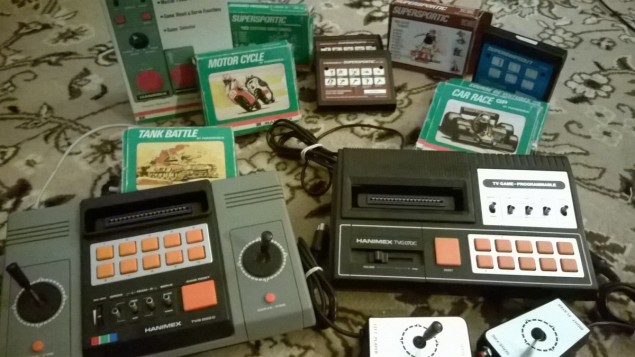
My Hanimex collection. I have a Fountain Force 2 system with games from New Zealand too. Will photo that on weekend or maybe being it in for you to look at?
Does anyone remember this Koala Joystick for the Commodore 64?
Contributed by: Helen
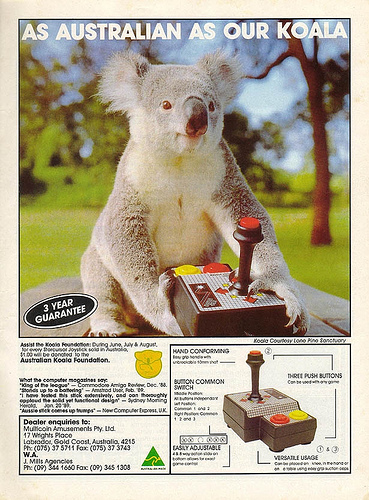
Distributed by Multicoin Amusements on the Goldcoast this impressive arcade style joystick promised it was as Australian as the Koala.
80s gaming – Commodore 64
Contributed by: Chad Habel
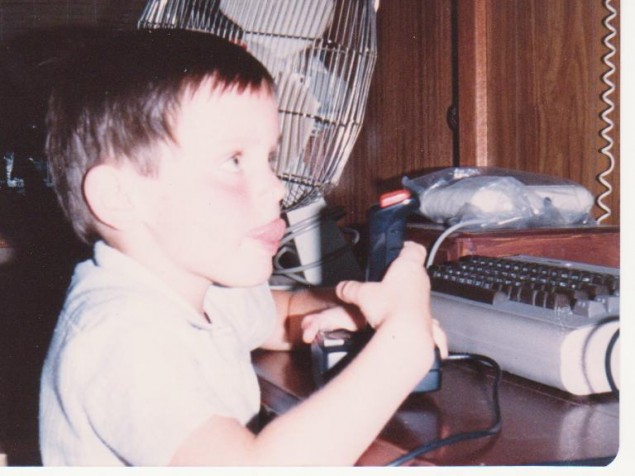
This is me enjoying one of my earliest gaming experiences in the early 80s. The system was the Commodore 64, and my parents figured that computers were likely to be important in the future and so they wanted to make sure that we grew up surrounded by them. The 64 was particularly useful for early digital literacy development because it had some very basic programming built into the OS interface.
Load “Awesome memory”,8,1
Inflation, exchange rates and value for money – the changing face of Magazines
Contributed by: Kevin Phillips
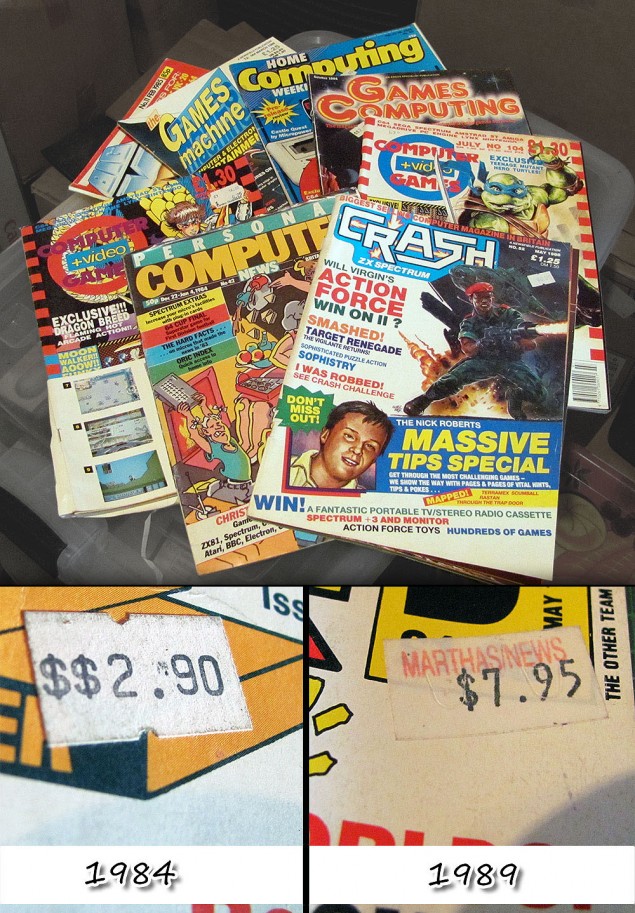
In just 5 years, the prices literally doubled on Computer Magazines here in NZ. As prices increased, the number of pages decreased… And program listings phased out in favor of reviews for commercial games.
Of course, there was a sudden inclusion of cover cassettes, featuring commercial software, demos and so on. At the start, many of the magazines would arrive in NZ with “Not available in New Zealand” stickers instead…
By the end of the 80’s, the art of programming in games was starting to completely die off. That era seemed to be over sadly.
Where it all began – learning to program in 1K of RAM
Contributed by: Kevin Phillips

We all had to start somewhere. While repacking old cardboard box loads of 80’s magazines into more protective plastic containers, I surprisingly ran across this book!
Its my first foray into computer programming, and 34 games meant I had plenty of them to play on my brand new ZX81 at the time. Its this book I can credit as my main learning resource for computer programming.
I recently typed in one of these games into an emulator. Its amazing that some of these games are quite playable given how little memory 1k was…
learning by example – typing in games from Magazines
Contributed by: Kevin Phillips
Quite recently, I managed to recover a handful of old cassette tapes with games I typed in from magazines saved on them. To my surprised, literally all of these actually worked and I hence went on to archive them online for anybody interested in playing them (I’ll post the links at the end of this speel).
That’s pretty much where and how I think many people (including myself) built their skills in games programming. I recall getting new magazines each week, sitting at home and typing in loooong listings of games to play.
Sometimes they were awful, sometimes they were pretty cool… If it was a great game, it got saved. These days, its funny to think how much time I’d spend typing in a game to just type “NEW” and start a new one… Without saving…
These days – if I do something that takes time, I’ll save it and back it up somewhere. Obviously, I don’t have to dig around for a blank cassette when I can just save immediately onto the hard drive of a PC.
The videos I recorded when a request was made on Facebook for material to be part of the “From Bedrooms to Billions” documentary (Due out in May – can’t wait). But enjoy the watch as I prove that old age doesn’t make me a better game player! ?
For those interested in running these on an Emulator, the files can be downloaded from here – in TZX (virtual cassette) format:
https://dl.dropboxusercontent.com/u/9174107/Fun_basic_games_1.zip
https://dl.dropboxusercontent.com/u/9174107/Fun_basic_games_2.zip
https://dl.dropboxusercontent.com/u/9174107/fun_basic_games_3.zip
Preshift tables – from 32 characters to 256 pixels
Contributed by: Kevin Phillips
![]()
In the 80’s, not all machines could access the screen at a per-pixel level easily. Most were a case of for every 8 pixels, 1 byte of screen memory would be used. Each little ‘bit’ inside this byte of memory was treated as a dot on screen. This, in laymans terms, means that if you wanted to move game characters super-smooth, a pixel on screen would be a “bit” inside an 8 pixel byte. Clever maths would be involved to translate a pixel, to a memory location and then to a bit inside a byte (sounds more complex then it was, really)
There was no “writing to a pixel” – it was in 8 pixel blocks at a time. So how did I get things moving a little smoother then 8 pixels (or “1 character”) blocks at a time when designing games?
The solution was pre-shift tables… That is, I would design a sprite for a game that was 1 character (8 pixels) wider then it needed to be. A second (or multiple) copy of the same sprite moved across a number of pixels would be also made, and then an X and Y coordinate value would have some maths applied to it so that the sprite was drawn at the correct location on this “higher res” location, making games look a lot smoother.
The other thing that also had to be done back then was not just to draw the sprite on screen, but it would have to be deleted before it was drawn again. As it was in the day, some games would start to look a little flickery… Tricks like masks came later for me, but for speed there were many techniques from just deleting all the “bytes” to 0, or using the computers processor to apply a ‘boolean’ to quickly flip bits around in a single command…
These concepts would come up time and time again, so I wrote it all down in a book so I would always have a reminder/reference to come back to… For anybody interested in a little “guide” to this whole concept of pre-shifted sprites, collision detection, etc on the ZX Spectrum :
https://drive.google.com/file/d/0B-yNJZpBnrutS1RINVhKMjJfVGc/edit?usp=sharing
Its all in the Algorithms…
Contributed by: Kevin Phillips
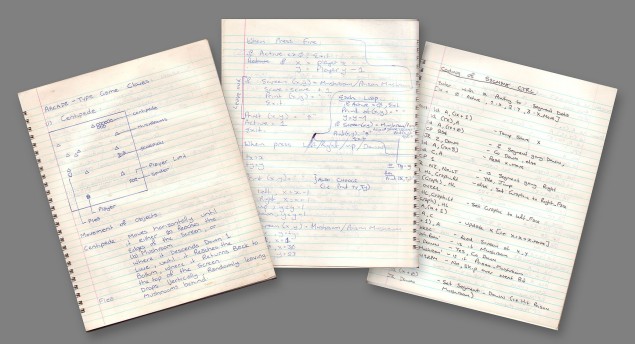
Often before any coding begins, I would transfer the plan in my head about just how things worked down onto paper. Sometimes I needed paper to draw up visuals, or to scribble bench tests for code to make sure that the numbers would add up/work.
This I recently dug up, a plan for writing a centipede arcade game clone on the ZX Spectrum. All the algorithms and concepts were in place, as well as a couple of pages of Z80 Assembler at the end. I even dug up the original source file on tape for this (called “Armourpede” (its what it says at the top when loaded in ZEUS assembler)) and from memory I seem to recall that this is all about animating a centipede on screen… (Hmmm, now I’m going to have to review it and test it)
Its how games would start (including the many old basic games from many years prior) – however not all game designs were written as neatly in books, but instead a variety of loose bits of paper that will have been lost over time.
For anybody interested in reading this document (scanned last week from start to end) then you can grab a PDF file here:
https://drive.google.com/file/d/0B-yNJZpBnrutdUZCaUluMDhnMzQ/edit?usp=sharing
Gemrun
Contributed by: Kevin Phillips
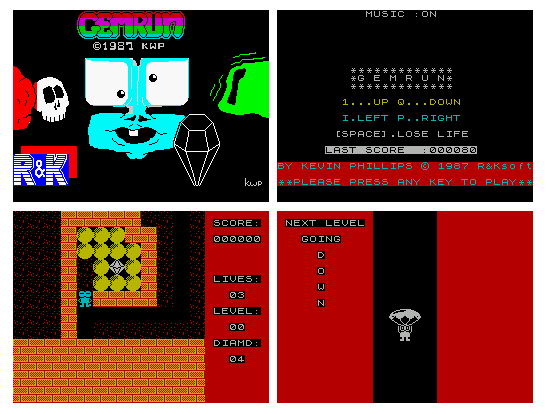
I wrote a lot of games over the 80’s… Most are lost, gone, or just fond memories – likely thrown away on C90 cassettes where I would have saved them. Long play cassettes always had a bad habit of stretching, and then you’d get that whole “wobble” in the audio making it almost impossible to load. So – into the trash they’d go…
As I’m archiving away, I’ll manage to find a few of these once-lost projects still recoverable (from C10 or C20 cassettes) – and Gemrun is one of them. I wrote this in 1987 over a week while staying at a friends place. His parents let me use an old 20″ Black and White TV set, and off I went.
I still have the Assembler code in a print out – which is faded, and is something like 5+ meters long (its small 6″ wide thermal paper). I will try and scan it some time… I’m sure I can probably recover a lot of the faded print, but at 5m – that’s a lot of scanning! ?
If anything, this was the largest machine code project I did, and one where I actually *completed* the project. Most my completed games in the past were written mostly in basic (and occasionally some small machine code functions).
Onto the game…
It was inspired by Boulderdash, and in this game you simply had to collect a certain number of gems and get back to the exit (usually at the start location in the game) to go to the next level. As you would dig, you would dislodge earth under boulders which would then fall down and fill the empty areas of the map.
When you got enough gems, sometimes you’d be completely trapped and not be able to return. Unfortunately the only way to end it is to press the Space key and lose a life. Keys to play are on the menu screen (1,Q,I,P and Space)
If you want to play this with an emulator (ZXSpin, Spectaculator, etc), its available zipped up (a .z80 snapshot, plus PDF of the map) on my google drive:
https://drive.google.com/file/d/0B-yNJZpBnrutMHNyc250NzNsdkU/edit?usp=sharing
What a tidy workstation…
Contributed by: Kevin Phillips
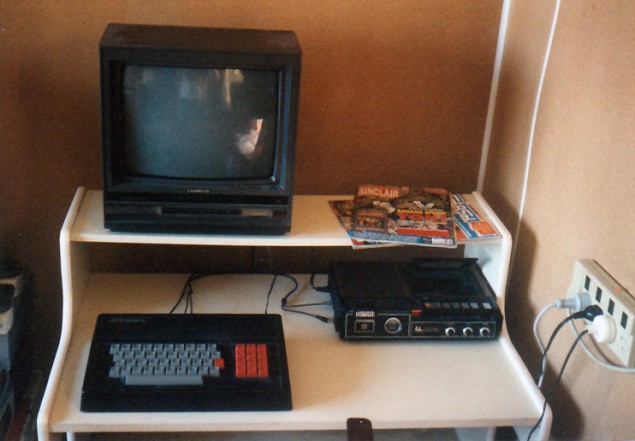
A piccy I recently found (in an album – it was amusing to hear my 7yr old niece ask me “Why are you keeping photographs inside a book?” – I guess most people keep their photo’s digitally these days (however physical memories will probably be less volatile to deletion then digital ones))
For back in 1989 when this photo was taken, It does look exceptionally tidy for what was my room – the old ZX Spectrum, 14″ Kambrook TV set and National cassette recorder sitting on a kitset computer desk.
What you *can’t* see however, is the mess in the room! A collection of cassette holders (mostly those clip-together 4-tape plastic ones by BASF (if anybody remembers those)), stacks of boxes with magazines, and a couple of drawer-loads of cassettes as well…
I used to come home from work and fire this up each night. Its in 1989, when my parents moved us from Auckland city out to Waiheke Island. My brother and I would share a sleep-out, partitioned by a wall and sliding door. I would code, and my brother would occassionally come through and draw graphics in Melbourne draw.
A couple of years later I moved to a flat with a coworker – I took all of this gear with me, and I kept coding with it until the early 1990’s – probably eventually stopping around 1994 after I got my first PC. The last game I wrote (almost to completion too!) was a clone of Mine Sweeper (that old Windows game) for the ZX Spectrum, called “Nuke Em”…
Its all in the pixels…
Contributed by: Kevin Phillips
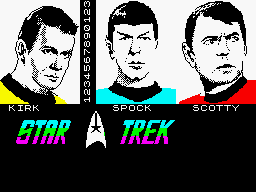
Computer art back in the 1980’s was a lot different then the million-colour, scanner/wacom tools that we have today. Every pixel had to be drawn, and in many a case, this was via cursor keys on the computer itself.
There was no shading – the number of colours were limited (and on the ZX Spectrum, you had blocks of colour in 8×8 pixels at a time – no per-pixel colour at all), and the solution was the use of thicker solid areas of pixels to create light or shadow areas. A checkboard dither pattern was also used to simulate the shading effects back then.
It was a load of fun – I enjoyed spending a couple of days sketching pixel-by-pixel in Melbourne Draw on my ZX Spectrum. I drew everything from game sprites to images from photo’s and Iron Maiden album covers this way.
This image was a series of characters drawn by hand from B&W photographs in a small “Star Trek Compendium” book. I was planning to use these to develop a Star Trek game – and having these “drawings” of the main characters was inspired by the artwork I’d seen in a magazine for an Atari ST game “Star Trek, the rebel universe”.
I loved the nicely drawn character heads in the game… But my game never got developed… Though these graphics still exist.
Today I still enjoy sketching and creating art, though I’m now doing it with a Wacom and not cursor keys and individual pixels.
Would you like to share a comment on the memory?
Compucolor II and CUVIC
Contributed by: Ted Stuckey
>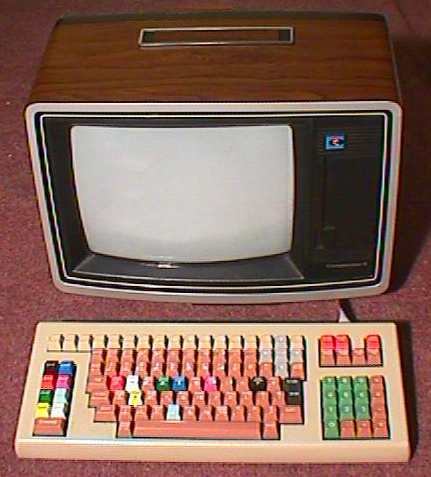
COMPUCOLOR II
In the 1970’s I watched the development of the micro processer and personal computers in magazines such as Popular Science, Mechanics Illustrated and Electronics Australia.
In 1979 I managed to convince the “Treasurer” of our household that these machines were going to change the world and that our children, who were aged 15, 13 and 12 at the time and I should be exposed to this technology. With her permission I purchased a Compucolor II Model 5 computer (32k of RAM) and extended keyboard. The package cost $2500 which was a hell of lot of money for us in those days.
I choose the CC II rather than the TRS80 and the Apple II because it came as a single unit with a 33cm colour monitor, a 5¼ inch disc drive (51Kb per side) and BASIC and File Control System in ROM. It was fitted with an Intel 8080A CPU, 16k of ROM, a 50 pin bus connector and an RS232 port. Blank formatted discs cost $9.95 for two and CCII program discs sold for $19.95. We also purchased an Epson MX80 printer.
My personal interests were to learn how to program in BASIC and get access to word processing, database and spreadsheet programs. I wanted our children to learn how to use a computer; to understand how they worked and how to use the programs. Games were not a high priority but they were a means to get the children involved. In fact the real game was to write a program that would work and then work out how to improve it.
Data entry and controls were restricted to the keyboard and almost without exception the arrow keys or the numeric keypad were used for directional control. In two player games the W, A, S and Z keys were used for the left player movement control.
The sampler disc came with One Armed Bandit (slot machine sim), Concentration (memory game) and Hangman. We purchased a few games discs which included Othello, Chess, Acey Duecy, Shoot, Tic Tac Toe, Blackjack, Pong, Tanks, Backgammon, Flight Sim, Lunar Lander, Adventure, Solo, etc.
We eventually had quite a large collection of all types of games including card games, adventure type games, simulations, etc. I purchased a word processor and database program but they still had a long way to go to equal the programs we use today.
I soon joined the Victorian CCII user group (CUVIC) that was started in 1980 by Neil Brandie, a computer store owner in High St, Windsor. We met once a month above his shop. This was a great help as there were many talented programmers and electronic boffins in the group to help solve your problems. My son and I attended the meetings and we learnt a lot, including how to program in assembler language. I ended up as Secretary/Treasurer of CUVIC which continued until 1987 when most of the members had moved on to new and more interesting machines. I purchased an Amiga.
Was it worth it? I think so. My son is a professor of Computer Science, one of my daughters set up the Games Studio in ACMI and taught games design. All of us use computers today for work and play and recognise their limitations.
If you are interested in CCII check out Jim Battles excellent website on www.compucolor.org He has a lot of information and the original programs with a CCII emulator.
My very first use of a home computer
Contributed by: Alan Laughton

A Tandy CoCo computer was lent to me by a mate over the 83/84 Christmas break. I connected it to the TV and with help of my daughter, we were off and running. This got me “hooked” and purchased the Australian made 32k Microbee the following February. In 85 it was updated to a Computer-In-A-Book Microbee with a 3.5″ floppy drive (floppies were $10 each back then). Upgraded the CIAB to a Premium 128k Microbee in late 85/early86. I still have it and has since been updated to a Premium Plus+ in 2012. Now with a new set of keys, more memory, SD card reader, etc it simply flys. The MSPP has just about all the games, well all the main ones, so every now and then I still fire it up to play Defender, Emu Joust, Scrambler, King Kong, Scavenger, King Tut, Cosmic Fighter, etc. I still havent finished Bunyip Adventure, I’m still working on that one ?
Back in 86, I started converting games listed in magazines but written for other computers (Apples ][e, Commodore, TRS-80) to run on the Microbee. For some it was easier to write them from scratch than to convert. Was all good fun. I even converted, only last year, an early TRS-80 game written in Z80 machine code to run on the Microbee.
I could go on for ever, I think I should stop now.
Alan
Writing games in the 80’s
Contributed by: Roger Keating
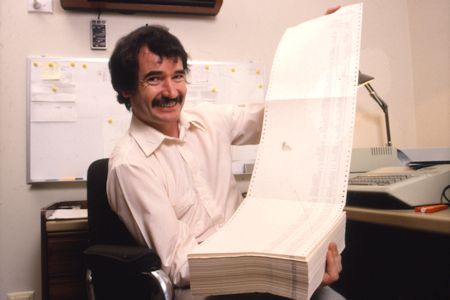
These where the days that required printouts to back up your work. The only thing I note here is that I look a lot, lot, younger.
This is about 1982 and shows the complete printout, in 6502 assembly code, of ‘Reach for the Stars’.
As this was my 8th game I had a certain confidence that all was going well.
Commodore 64 1986
Contributed by: Anonymous
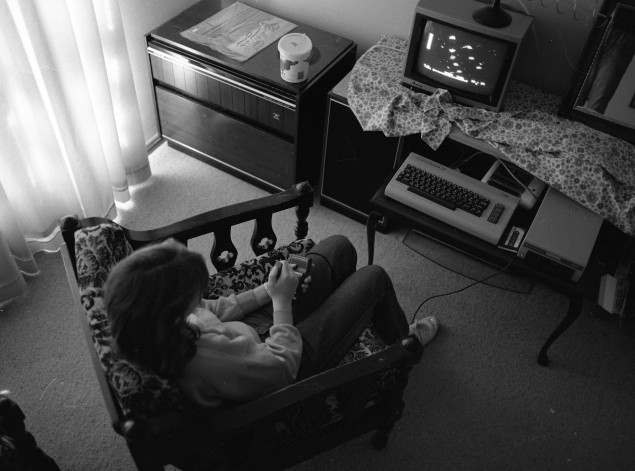
My daughter, Katie Scott, playing on Commodore 64 purchased Christmas 1985.
Playing ‘tennis’
Contributed by: Anonymous
>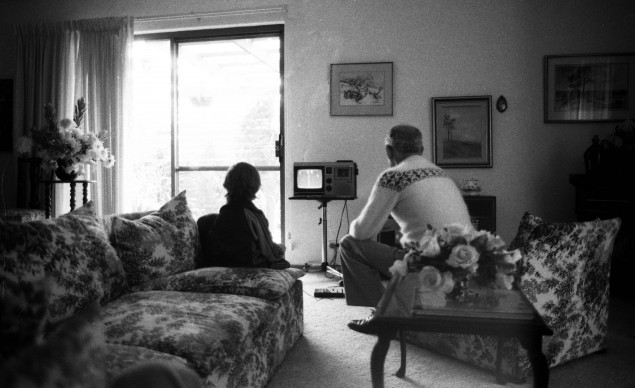
I took this photo when we visited my father for his 60th birthday, May 1981. My daughter and my father are playing an early version of ‘tennis’.
